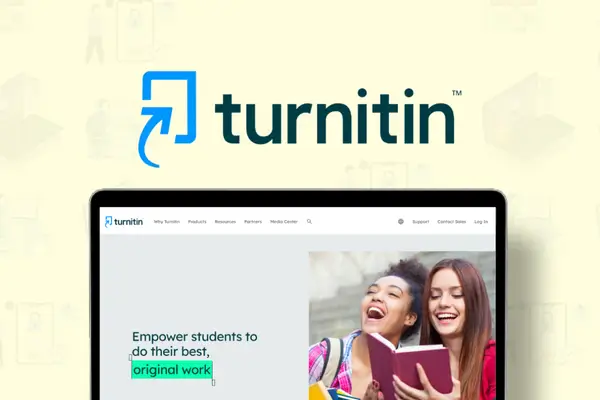Turnitin Review – Best Tool For Enhancing Student Accountability In Writing
Turnitin is a powerful plagiarism detection tool that helps maintain academic integrity by comparing submissions against a vast database. With Turnitin, users can foster a culture of ethical writing in educational environments.
This comprehensive Turnitin Review covers everything you need to know about the best AI detection tool. The goal of Turnitin is to support academic integrity by giving teachers and students access to resources that enhance their writing and learning. By preventing plagiarism and promoting an honest and creative culture in the classroom, they help universities maintain the highest standards of academic performance.
What is Turnitin?
A plagiarism detection tool called Turnitin assists academic institutions and teachers in maintaining academic integrity. By comparing submitted work to a vast database of student submissions, publications, and other resources, it searches for text that matches.

Turnitin gives comments on the originality and quality of writing, allowing students to do better and teachers to spot possible copying. Teachers and students can utilize the service because it is connected with multiple learning management systems.
How does Turnitin work?
Turnitin operates by reviewing submitted papers and cross-referencing them with a large database of scholarly articles, student papers, and web information. Here is a quick rundown of how it works:
- Submission: Usually inside a learning management system like Canvas, students turn in their papers via an integrated platform.
- Text Matching: Turnitin looks for patterns or resemblances between the text and sources that are already in its database.
- Originality Report: By highlighting language that matches and including links to the original sources, the software creates an originality report. A similarity score is also provided, which shows what proportion of the submission is comparable to other content.
- Tools for Feedback: Turnitin provides teachers with extra resources, like grading tools and feedback choices, to help students write better.
- Continuous Learning: By allowing students to edit their work in response to criticism, the technology promotes a creative and honorable learning environment.
Who should use Turnitin?
Turnitin is mainly intended for:
- Teachers and instructors use it to check for possible plagiarism in student work, upholding standards of originality and protecting academic integrity.
- Students: By using Turnitin, students can verify their own work for plagiarism before submitting it, which can help them write better and prevent inadvertent academic dishonesty.
- Academic Institutions: As part of their regulations about academic integrity, schools, colleges, and universities use Turnitin as a tool for grading student work.
- Writing centers: These facilities can use Turnitin to give students feedback and assistance as they work to enhance their writing abilities and comprehension of plagiarism.
- Turnitin can help encourage originality and enhance writing quality for all those engaged in the educational process.
Pros and Cons of Turnitin
Pros of Turnitin
- Effectively detects any plagiarism by cross-referencing contributions with a sizable database.
- Originality Reports: Helps with academic integrity evaluations by offering comprehensive reports that highlight matched content and sources.
- Feedback Tools: These tools improve the feedback process by allowing instructors to directly evaluate and remark on student submissions.
- This educational resource teaches pupils the value of original work and correct citation procedures.
- Integration: It easily interfaces with a number of learning management systems, making it intuitive for teachers and students alike.
Cons of Turnitin
- False Positives: May flag common phrases or properly cited materials as plagiarism, leading to confusion.
- Cost: Institutions may incur significant costs for licenses and subscriptions, which can be a barrier for some schools.
- Limited Database: While extensive, Turnitin’s database may not cover all sources, potentially missing some instances of plagiarism.
- User Experience: Some users find the interface complex or not intuitive, which can hinder effective use.
- Privacy Concerns: Submissions are stored in Turnitin’s database, which raises questions about ownership and student privacy.
Overall, while Turnitin is a powerful tool for promoting academic integrity, it is important to consider these pros and cons when implementing it in educational settings.
Main Features Of Turnitin
Turnitin offers a range of main features that enhance academic integrity and support the educational process. Here are some highlights that Saas Review Tools has researched and analyzed:
AI Writing Detection Tool
A state-of-the-art tool on Turnitin, the AI Writing Detection Tool is intended to recognize and evaluate the use of AI-generated content in student submissions. With the use of sophisticated algorithms, this tool analyzes text coherence, stylistic choices, and writing patterns to help instructors distinguish between work produced by humans and work aided by artificial intelligence.

Turnitin promotes original writing among students and supports academic integrity by offering comprehensive insights regarding the possibility of AI involvement. By adding this technology to Turnitin’s already-existing plagiarism detection framework, educators may uphold strict standards of authenticity in student assessments, improving the evaluation process overall.
This tool encourages a greater comprehension of the ethical considerations surrounding AI in education while also assisting instructors in spotting possible academic dishonesty.
Academic Integrity Checker Tool
By confirming that submitted work complies with originality and correct citation requirements, Turnitin’s Academic Integrity Checker Tool is an essential tool for encouraging students to write ethically.

In order to identify possible cases of plagiarism, this program compares student submissions to a large database of scholarly articles, student papers, and other sources. It allows teachers to lead insightful conversations on academic integrity with their pupils by producing an extensive originality report that highlights language that matches and provides obvious links to the original sources.
The Academic Integrity Checker stresses the value of integrity in academic work, which helps instructors enforce institutional policies and teaches students about appropriate writing techniques. This promotes a climate of trust and accountability in learning environments.
Integrity Of Research Tool
The Integrity of Research Tool on Turnitin is a crucial component meant to bolster the validity and precision of scholarly research. By comparing research papers to an extensive database of academic journals, articles, and other pertinent sources, this program assesses research papers for originality.

Through the detection of possible plagiarism and deficient citation techniques, it assists researchers in guaranteeing that their work is both morally and intellectually sound. In addition to highlighting information that matches, the application offers guidance on appropriate citation techniques, enabling researchers to improve their knowledge of academic standards.
This encourages a dedication to honesty in research methods, enabling scholars to provide reliable, excellent work that advances their fields of study. Turnitin contributes to preserving the standards of intellectual communication and the trustworthiness of academic papers by emphasizing research integrity.
Online Plagiarism Detection Tool
By successfully detecting instances of plagiarism in student submissions, Turnitin’s Online Plagiarism Detection Tool is a feature that is essential to upholding academic integrity. Using sophisticated algorithms, this tool scans and compares submitted documents with a large database that contains academic journals, billions of online pages, and prior student papers.

After a submission is examined, an originality report is produced that shows educators the originality of the content by highlighting language that matches, citing the sources of the matches, and displaying a similarity score.
This thorough study is a useful tool for professors to identify possible wrongdoing as well as for students, as it helps them learn the value of original work and appropriate citation techniques. Turnitin gives educational institutions the capacity to promote an honest and accountable culture in scholarly work by incorporating this feature into the workflow.
Turnitin Pricing
“Turnitin does not offer individual license purchases to users. Many institutions offer plagiarism detection services from Turnitin. Please ask your school or university whether they are using Turnitin and if the service may be available to you under their license”.
Turnitin provides institutional licenses for schools and universities instead of selling individual licenses. Unlike many other competitors’ plagiarism checkers, the company doesn’t list its prices on its website.
Colleges and schools interested in a quote should speak with Turnitin directly. They can then determine whether or not to move forward with the acquisition.
While Turnitin’s price isn’t stated on the internet, some educational institutions have revealed it for transparency’s sake. Universities estimate that Turnitin costs $3 annually for each student.
Conclusion: Turnitin Review
To sum up, Turnitin is a unique resource that is essential to the academic environment since it encourages authenticity and integrity in student work. Its extensive features, which include originality reports, plagiarism detection, and sophisticated feedback systems, give teachers the tools they need to maintain the highest levels of academic integrity.
Turnitin not only helps prevent plagiarism but also improves the learning process by encouraging a culture of ethical writing and giving students insightful feedback on their work. Turnitin continues to be a vital ally in helping educational institutions meet and sustain academic standards while they negotiate the difficulties associated with creating digital content.
2 reviews for Turnitin Review – Best Tool For Enhancing Student Accountability In Writing
You must be logged in to post a review.
No comments yet
Turnitin Alternatives and Competitors
We are checking and will update soon. If you know any suitable alternative tools, please comment down below and suggest them to us.





Link
Overall, Turnitin is great for making my written assignments more efficient to collect, score, and give comments on. It takes the areas of writing feedback that can be automated (conventions and originality) and automates them, leaving me more time to focus on helping students improve their skills and content knowledge. It’s also an excellent tool for distributing papers for peer review or collecting any assignment that can be created digitally.
Link
I love this tool as does my department. It serves its purpose well. I really like the ease of some of the basic tenets of the program and in many cases it has helped my students learn from the feedback provided through the program. One of the major downsides to the program is that numerous features of the program are not intuitive. The user interface can be confusing to some and much training is required for most users to get them comfortable with the basics.